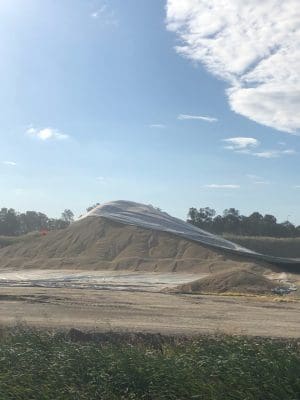THE WORSENING drought in much of New South Wales is buoying values for feedgrain, which appear to have hit a ceiling of $400 per tonne delivered Darling Downs.

Grain at a pad in Brisbane awaits transfer to end users in southeast Queensland.
This price is in line with what some Downs feedlots are paying for wheat and barley being trucked in from as far away as northwest Victoria, with a road freight component of around $120/t.
Traders told Grain Central that graziers in northern, central and parts of southern NSW are buying feedgrain hand-to-mouth to feed sheep and cattle in the face of dropping temperatures, dwindling pastures and a tightening hay supply.
Hand-to-mouth transactions usually attract a premium price, and though each transaction may be small, additional months of feeding in 2018 are changing regional supply/demand balances.
Cottonseed $50/t higher since April
Keen grazier demand for cottonseed has pushed seed prices about $50/t firmer since ginning began in April.
The cottonseed export market,which normally cranks up at this time of year ahead of the emergence of new crop northern hemisphere export competition, is unseasonally slow this year because it cannot afford to pay local prices for its trade into southeast Asia.
“Australian cottonseed is uncompetitive for export at current values,” Woodside Commodities broker, Hamish Steele-Park said. Delivered container terminal (DCT) Melbourne was bid this week at A$365/t June shipment, and offered $380/t DCT.
Most of the recent activity has been in the domestic market for cattle in Queensland, NSW and Victoria, while grazier demand in NSW has had a strong appetite for cottonseed, along with hay and grain, to keep sheep and cattle alive.
Its geographic spread from central NSW though the Hunter Valley and Tablelands has seen grazier demand ex Macquarie Valley gin sites Warren and Trangie trade $305/t for delivery in the next month or so.
“In the north, the delivered southern Queensland feedlot market has been trading small volumes between $350/t and $355/t say for June, July and August. Moree June/July ex gin has been trading around $330/t and Namoi Valley ex gin $10/t below Moree. “
…………………………………………………………………………………………………………………………..
Table 1: Indicative market values this past week for trade quantities even spread over delivery period June/July/August.
| Stockfeed wheat ($/t) | Feed barley ($/t) | Cottonseed ($/t) | |
| Delivered Darling Downs | 400 | 410 | 355 |
| Ex farm/ex gin MIA NSW | 310 | 310 | 310 |
……………………………………………………………………………………………………………………………….
A New South Wales trader said graziers had strong demand for prompt cottonseed as everyone wanted seed at the front end of the delivery period and they were paying a premium for it.
Prices spread evenly through the delivery period to September were $20/t below the spot price.
The trader also said the corn market had risen substantially in recent weeks to around $345/t ex farm Murrumbidgee Irrigation Area (MIA).
MIA corn would normally be heading south into Victoria’s Goulburn Valley commercial feeder markets but, like cereals and hay, it was moving in all directions to feed paddock livestock.
Lupins in the Murray Valley have been trading at around $410/t ex farm.
The trader said that in addition to long-distance road haulage from the Victorian and South Australian Mallee districts to the Darling Downs in Queensland showing desperation in the market, the number of cargoes, rumoured at around six to eight, to be delivered to Brisbane over the coming months was expected to cap the Darling Downs market at around $400/t, the level it hit last week.
“This movement of grain around the coast could continue into next year. We’re on a knife edge right now in terms of production.”
South Australia stock of feed grains tight
Trucks, trains and ships have been hoovering wheat and barley out of South Australia for eastern states’ domestic consumption for months now, in addition to an already strong export shipment program, pushing SA wheat prices up around $50/t since harvest.
A trader close to the procurement of South Australian grain for export and domestic markets said if the movement of grain out of the state was to continue there was a chance SA could become deficit grain this year.
The recent demand for animal feed has placed pressure on the availability for human consumption users of wheat and barley.
Most flour milling export customers pay a premium for Australian wheat because particular quality traits allow millers to raise the quality of their consumer products by blending flours made from higher and lower quality wheats.
Not only were domestic consumers in South Australia paying a premium to buy grain away from the boats, but also stocks at main export competitive sites including Port Lincoln and Port Giles had dwindled.
Alternative stockfeed wheat and barley supply would likely begin to flow from Western Australia for shipment to Brisbane, and therefore preserve balances of premium barleys and milling wheats from South Australia suited to human consumption markets in the Pacific Rim region.
Rain makes grain
Feedlots, graziers and arable farmers have seen it all before. Feedlots we spoke to were at least satisfied that grain was available for the coming months, even though it was expensive.
At this time when so much hinges on rain, cottonseed supply has been reasonable priced, is readily available locally and would remain in the feeding rations at maximum inclusion rate.
The future depends on rain. Who knows when it will come, but it will come.
Grain Central: Get our free daily cropping news straight to your inbox – Click here
